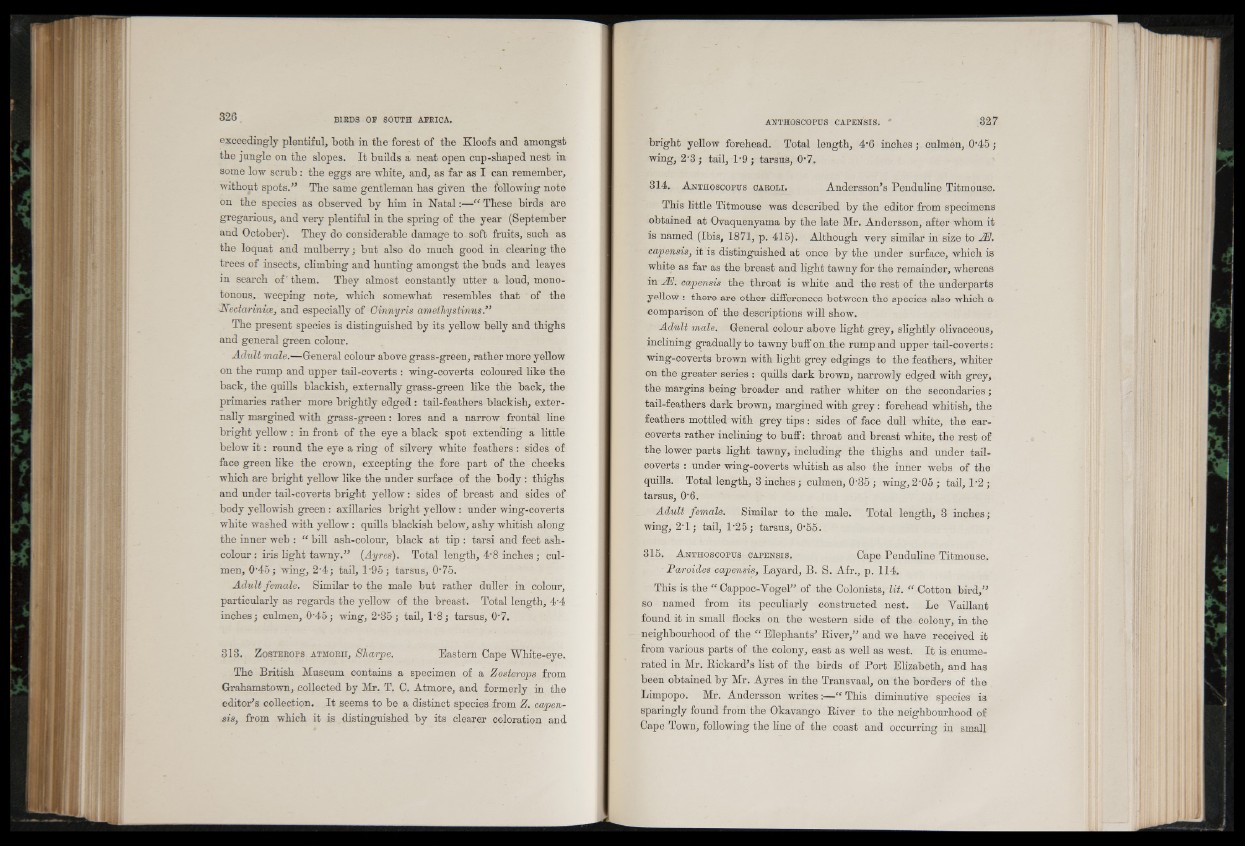
exceedingly plentiful, both in the forest of the Kloofs and amongst
the jungle on the slopes. It builds a neat open cup-shaped nest in
some low scrub: the eggs are white, and, as far as I can remember,
without spots.” The same gentleman has given the following note
on the species as observed by him in Natal:—“ These birds are
gregarious, and very plentiful in the spring of the year (September
and October). They do considerable damage to soft fruits, such as
the loquat and mulberry; but also do much good in clearing the
trees of insects, climbing and hunting amongst the buds and leayes
in search of' them. They almost constantly utter a loud, monotonous,
weeping note, which somewhat resembles that of the
JSfectarinice, and especially of Ginnyris amethystinus.”
The present species is distinguished by its yellow belly and thighs
and general green colour.
Adult male.—General colour above grass-green, rather more yellow
on the rump and upper tail-coverts : wing-coverts coloured like the
back, the quills blackish, externally grass-green like the back, the
primaries rather more brightly edged : tail-feathers blackish, externally
margined with grass-green: lores and a narrow frontal line
bright yellow : in front of the eye a black spot extending a little
below i t : round the eye a ring of silvery white feathers : sides of
face green like the crown, excepting the fore part of the cheeks
which are bright yellow like the under surface of the body: thighs
and under tail-coverts bright yellow: sides of breast and sides of
body yellowish green : axillaries bright yellow: under wing-coverts
white washed with yellow: quills blackish below, ashy whitish along
the inner web : “ bill ash-colour, black at tip : tarsi and feet ash-
colour : iris light tawny.” (Ayres). Total length, 4‘8 inches ; cul-
men, 0‘45; wing, 2-4; tail, T95; tarsus, 0‘75.
Adult female. Similar to the male but rather duller in colour,
particularly as regards the yellow of the breast. Total length, 4-4
inches; culmen, 0‘45; wing, 2'35; tail, 1*83 tarsus, 0-7.
313. Z osterops a tm or ii, Sharpe, Eastern Cape White-eye.
The British Museum contains a specimen of a Zosterops from
Grahamstown, collected by Mr. T. C. Atmore, and formerly in the
editor’s collection. I t seems to be a distinct species from Z. capensis,
from which it is distinguished by its clearer coloration and
bright yellow forehead. Total length, 4'6 inches; culmen, 0‘4 5 ;
wing, 2-3; tail, T9; tarsus, 0'7.
314. A nthoscopus caroli. Andersson’s Penduline Titmouse.
This little Titmouse was described by the editor from specimens
obtained at Ovaquenyama by the late Mr. Andersson, after whom it
is named (Ibis, 1871, p. 415). Although very similar in size to JE.
capensis, it is distinguished at once by the under surface, which is
white as far as the breast and light tawny for the remainder, whereas
in 2E. capensis the throat is white and the rest of the under parts
yellow : there are other differences between the species also which a
comparison of the descriptions will show.
Adult male. General colour above light grey, slightly olivaceous,
inclining gradually to tawny buff on .the rump and upper tail-coverts:
wing-coverts brown with light grey edgings to the feathers, whiter
on the greater series : quills dark brown, narrowly edged with grey,
the margins being broader and rather whiter on the secondaries;
tail-feathers dark brown, margined with grey: forehead whitish, the
feathers mottled with grey tips : sides of face dull white, the ear-
coverts rather inclining to buff: throat and breast white, the rest of
the lower parts light tawny, including the thighs and under tail-
coverts : under wing-coverts whitish as also the inner webs of the
quills. Total length, 3 inches; culmen, 0-35 ; wing, 2-05 ; tail, T2 ;
tarsus, 0‘6.
Adult female. Similar to the male. Total length, 3 inches;
wing, 2T ; tail, 1*25; tarsus, 0'55.
315. A n thoscopus c a pe n s is . Cape Penduline Titmouse.
Paroides capensis, Layard, B. S. Afr., p. 114.
This is the “ Cappoc-Yogel” of the Colonists, lit. “ Cotton bird,”
so named from its peculiarly constructed nest. Le Vaillant
found it in small flocks on the western side of the colony, in the
neighbourhood of the “ Elephants’ River,” and we have received it
from various parts of the colony, east as well as west. It is enumerated
in Mr. Rickard’s list of the birds of Port Elizabeth, and has
been obtained by Mr. Ayres in the Transvaal, on the borders of the
Limpopo. Mr. Andersson writes:—“ This diminutive species is
sparingly found from the Okavango River to the neighbourhood of
Cape Town, following the line of the coast and occurring in small